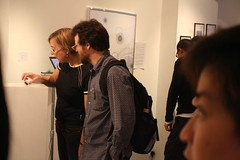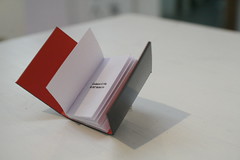17 Nov 2007, Hong Kong
My participation in the group exhibition, 14QK: Art Responds to 14K - The Many People Show (Para/Site, Hong Kong, 17-24 Nov 2007) consists of a miniature book (1 x 2.2 x 0.4cm), entitled Confessions of a slug, containing a short essay discussing my take on the 14QK show, but more generally, on political or activist art. In it, I shared on my attraction to and disability in making political art.
Transcript follows the image documentation:

Gallery view (with visitors reading the book)

Installation view
"Confessions of a slug
© 2007 Michael Lee
Things work at lightning speeds in Hong Kong. One day, you read in the papers about a local lifestyle store’s launch of t-shirts bearing the name of a triad society. A few days after, you hear that the police raided the stores, confiscated those tees and arrested the store’s boss and staff. The next, you learn that all detainees were released and the boss made a public apology on the matter. Two weeks on, you are involved in the launch of a group exhibition of works by 32 (as of 13 Nov 2007, and still counting) artists responding to the incident, at an alternative art space.
Two observations are of personal interest. The first is the resemblance between the reaction speeds of the policing authorities and the cultural practitioners. The second is how, given my professed avoidance of an activist stance in my practice, I have agreed to involve myself in what could arguably be a politically charged platform. Speed and politics have awakened me.
The capacity to think and act fast is a valuable instinct. A slow judgment or hesitant move can cost one a meal or a date, a career opportunity or even life itself. Speed is a most celebrated commodity of city life along with related notions of pragmatism and efficiency. Economic modernism of the capitalist kind goes hand in hand, though not always in harmony, with its political arm: democracy. Thinking, thinking fast, thinking critically against domination, thinking for the realisation of one’s fullest potential – are traits of a modern individual. Establishments that allow dissident voices to exist do so with the belief, actual or apparent, in the benefits of a diversity of ideas, so long as these do not drown out or overturn the system. In the wake of 911, however, the faintest association with organised crime is an understandable cause for concern. In this regard, just as it is not difficult to understand the various purposes that the recent police arrest serve, not limited to acting on reliable sources and precise calculation, erring on the wrong side of caution and providing a visual spectacle, it would seem equally easy to relate with the timely interventions by artists and intellectuals questioning the official suppression of cultural expression. Both kinds of intervention aim at the sustenance of culture, though of its different aspects and in different ways. One ensures the boat does not rock till it cracks or capsizes, the other is bent on finding out what may be on the boat’s undersides. They seem necessarily exclusive of each other. Need they be?
With the exception of the Rodney King incident, police actions hardly receive strong public backlashes. Neither does artistic activism. At the most, we question the harshness of their moves or mock at their ineffectiveness or impracticality, but we do not question their intentions. Helplessly, willingly or nonchalantly, we let them ‘do their job’. We forgive, if not sympathise with, all actions and any miscalculation because we fear most the repercussions of inaction: The cause justifies the means.
Much of critical art practice employs one of two expressive modes: angst-filled literalism and willy-nilly abstraction. For one, art provides a means for pursuing or illustrating a political end. For the other, art is a shelter against political sanction. If the point is to make a political statement or change, why (and how to) make art? Conversely, if one strives for universality by way of abstraction, then how do particular political events matter? What constitutes the work of art in an age of knee-jerk responses? Where is the art in art activism? How may art and politics relate for the betterment of life? These questions are important, among other things, for deciphering invention from regurgitation, insight from noise.
Why am I here? I knowingly implicate myself in what I am suggesting to be hasty art practice and evasive politics, first by involving myself in the said exhibition that naturally had a short notice, then by not taking sides, and finally by hammering this texts out hastily, albeit inevitably. Perhaps I appreciate too much this public platform for making and presenting a new piece of work. Perhaps I hope to lend a sense of richness to what I most fear as a gathering of unanimous voices against domination alongside abstract expressions that attempt to little avail to give insight to the human condition. Perhaps I wish to find a slow space for deliberation, uncertainty and indecision. Perhaps love.
Like the snail, the slug confronts the constant challenge of keeping itself alive, mobile, warm, moist and safe from predators. Mucus, which it secretes from its body, helps it do these and more. It also assists in reproduction. A hermaphrodite, the slug has both the male and female reproductive organs. During mating, two slugs overhang on a rope of their mucus and entwine each other into a corkscrew. A while later, the genitalia protrude from one side of each slug’s head and, too, twist around each other into a white rose. Sperm is exchanged. Slugs during mating are a textbook image of an ideal erotic relationship: their slow and delicate movements, the strangling embrace, the twisting and twining, the giving and receiving, the extension of oneself for the self and the other. But too much and too long of anything can be unhealthy. At times when genetalia get too entangled after mating, one slug may bite off its own or the other’s penis, allowing both to separate. The slug without a male reproductive organ will not grow another. It will henceforth assume a female role.
I am for an art of wonder, one that shows more than tells, intrigues as it informs, transforms as much as translates. I am for an art of humour, one that regards a tragedy as a joke and an opportunity. I am for an art that plays with whilst investigating life, thereby extending it. I am for an art that deals with politics without compromising on aesthetics, weaving conceptualism and craftsmanship. I am for an art of independence as well as of interdependence. I am for an art of lightning and storm behind the eyes, not just in front of them. I am for an art that lives on in new ways by leaving a seed or egg in the human imagination."
No comments:
Post a Comment